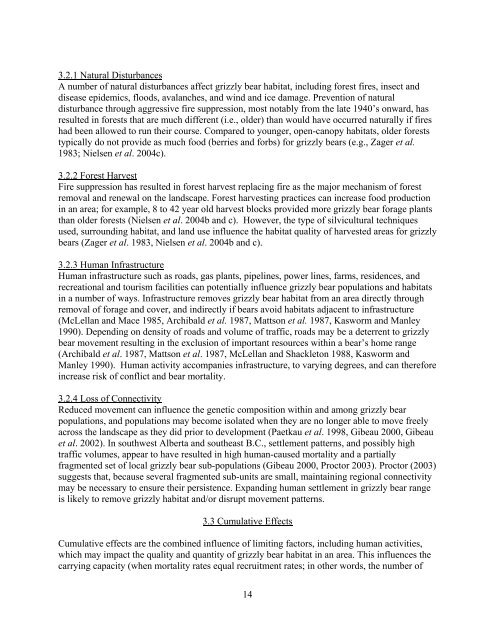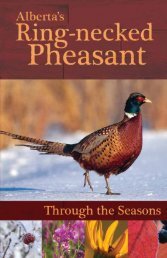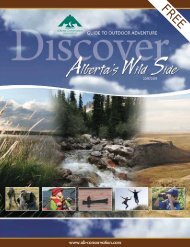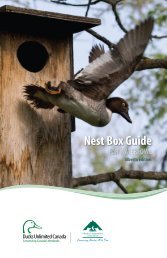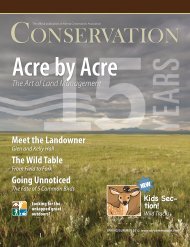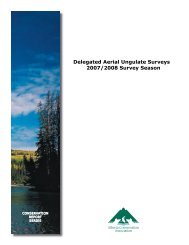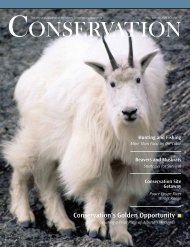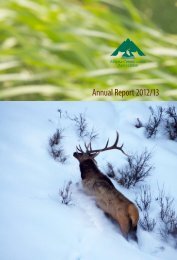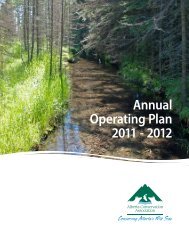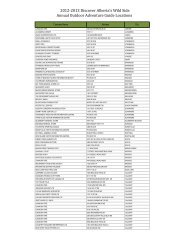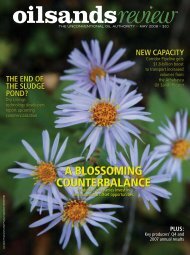Alberta Grizzly Bear Recovery Plan 2008-2013 - Alberta Sustainable ...
Alberta Grizzly Bear Recovery Plan 2008-2013 - Alberta Sustainable ...
Alberta Grizzly Bear Recovery Plan 2008-2013 - Alberta Sustainable ...
Create successful ePaper yourself
Turn your PDF publications into a flip-book with our unique Google optimized e-Paper software.
3.2.1 Natural Disturbances<br />
A number of natural disturbances affect grizzly bear habitat, including forest fires, insect and<br />
disease epidemics, floods, avalanches, and wind and ice damage. Prevention of natural<br />
disturbance through aggressive fire suppression, most notably from the late 1940’s onward, has<br />
resulted in forests that are much different (i.e., older) than would have occurred naturally if fires<br />
had been allowed to run their course. Compared to younger, open-canopy habitats, older forests<br />
typically do not provide as much food (berries and forbs) for grizzly bears (e.g., Zager et al.<br />
1983; Nielsen et al. 2004c).<br />
3.2.2 Forest Harvest<br />
Fire suppression has resulted in forest harvest replacing fire as the major mechanism of forest<br />
removal and renewal on the landscape. Forest harvesting practices can increase food production<br />
in an area; for example, 8 to 42 year old harvest blocks provided more grizzly bear forage plants<br />
than older forests (Nielsen et al. 2004b and c). However, the type of silvicultural techniques<br />
used, surrounding habitat, and land use influence the habitat quality of harvested areas for grizzly<br />
bears (Zager et al. 1983, Nielsen et al. 2004b and c).<br />
3.2.3 Human Infrastructure<br />
Human infrastructure such as roads, gas plants, pipelines, power lines, farms, residences, and<br />
recreational and tourism facilities can potentially influence grizzly bear populations and habitats<br />
in a number of ways. Infrastructure removes grizzly bear habitat from an area directly through<br />
removal of forage and cover, and indirectly if bears avoid habitats adjacent to infrastructure<br />
(McLellan and Mace 1985, Archibald et al. 1987, Mattson et al. 1987, Kasworm and Manley<br />
1990). Depending on density of roads and volume of traffic, roads may be a deterrent to grizzly<br />
bear movement resulting in the exclusion of important resources within a bear’s home range<br />
(Archibald et al. 1987, Mattson et al. 1987, McLellan and Shackleton 1988, Kasworm and<br />
Manley 1990). Human activity accompanies infrastructure, to varying degrees, and can therefore<br />
increase risk of conflict and bear mortality.<br />
3.2.4 Loss of Connectivity<br />
Reduced movement can influence the genetic composition within and among grizzly bear<br />
populations, and populations may become isolated when they are no longer able to move freely<br />
across the landscape as they did prior to development (Paetkau et al. 1998, Gibeau 2000, Gibeau<br />
et al. 2002). In southwest <strong>Alberta</strong> and southeast B.C., settlement patterns, and possibly high<br />
traffic volumes, appear to have resulted in high human-caused mortality and a partially<br />
fragmented set of local grizzly bear sub-populations (Gibeau 2000, Proctor 2003). Proctor (2003)<br />
suggests that, because several fragmented sub-units are small, maintaining regional connectivity<br />
may be necessary to ensure their persistence. Expanding human settlement in grizzly bear range<br />
is likely to remove grizzly habitat and/or disrupt movement patterns.<br />
3.3 Cumulative Effects<br />
Cumulative effects are the combined influence of limiting factors, including human activities,<br />
which may impact the quality and quantity of grizzly bear habitat in an area. This influences the<br />
carrying capacity (when mortality rates equal recruitment rates; in other words, the number of<br />
14


